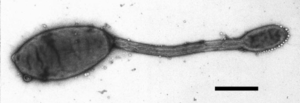Hyphomonas adhaerens: Difference between revisions
| Line 33: | Line 33: | ||
==References== | ==References== | ||
[1] Weiner, Ronald M., et al. "Hyphomonas adhaerens sp. nov., Hyphomonas johnsonii sp. nov. and Hyphomonas rosenbergii sp. nov., marine budding and prosthecate bacteria." International journal of systematic and evolutionary microbiology 50.2 (2000): 459-469. | [1] [http://http://ijs.sgmjournals.org/content/50/2/459.full.pdf Weiner, Ronald M., et al. "Hyphomonas adhaerens sp. nov., Hyphomonas johnsonii sp. nov. and Hyphomonas rosenbergii sp. nov., marine budding and prosthecate bacteria." International journal of systematic and evolutionary microbiology 50.2 (2000): 459-469.] | ||
==Author== | ==Author== | ||
Revision as of 18:24, 13 April 2013
Classification
Bacteria; Proteobacteria; Alphaproteobacteria; Rhodobacterales; Hyphomonadaceae; Hyphomonas
Species
|
NCBI: Taxonomy |
Hyphomonas adhaerens
Description and Significance
Adhaerens means "hanging on/sticking to".
Hyphomonas adhaerens is a budding/prosthecate bacteria that lives in a marine environment. The main body of the mother cell is a prolate spheroid, 1-2 μm in diameter with one prosthecum 0-2 μm wide x 1-5 μm long. It is motile by a single flagellum and the main body of the reproductive cell is surrounded by a capsular polysaccharide. It is gram-negative, not acid-fast, has no endospores, and is aerobic. Forms in colonies that are round and undulate and are 1-5 mm in diameter after three days at 30°C. Forms a thick biofilm in liquid media and grows optimally at 27-37°C. Optimum growth in ocean salt is 1.5-12% and pH at 5.7-8.7. It also reduces nitrate. [1]
Genome Structure
Describe the size and content of the genome. How many chromosomes? Circular or linear? Other interesting features? What is known about its sequence?
Cell Structure, Metabolism and Life Cycle
Interesting features of cell structure; how it gains energy; what important molecules it produces.
Ecology and Pathogenesis
Habitat; symbiosis; biogeochemical significance; contributions to environment.
If relevant, how does this organism cause disease? Human, animal, plant hosts? Virulence factors, as well as patient symptoms.
References
Author
Page authored by _____, student of Prof. Jay Lennon at Michigan State University.
<-- Do not remove this line-->

